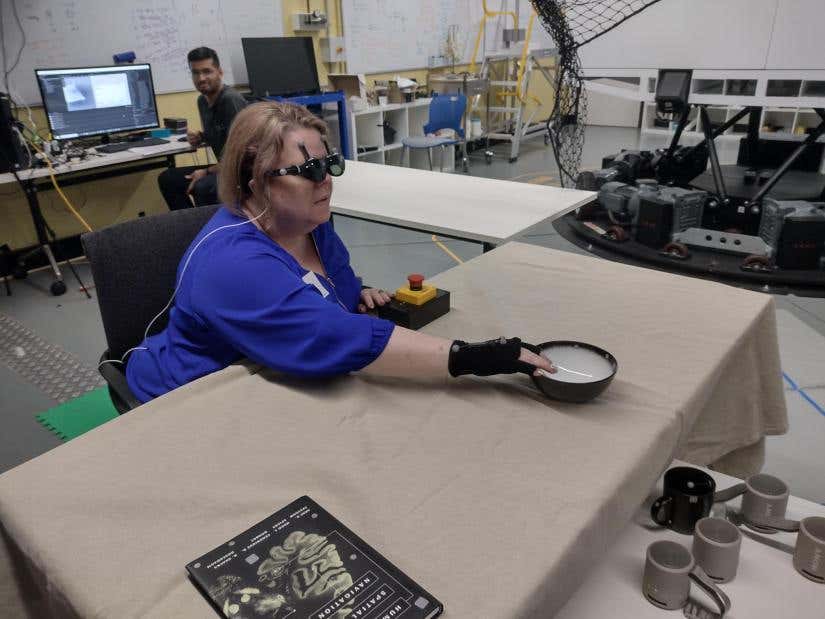Revolutionary new technology helps people see using sound
Smart glasses that use a technique similar to a bat’s echolocation could help blind and low-vision people navigate their surroundings

[Oct. 26, 2023: Staff Writer, The Brighter Side of News]
Australian scientists have unveiled a revolutionary invention, termed “acoustic touch,” with the ability to facilitate the process of 'seeing' through sound. (CREDIT: Lil Deverell)
In a ground-breaking revelation, Australian scientists have unveiled a revolutionary invention, termed “acoustic touch,” with the ability to facilitate the process of 'seeing' through sound. Developed as the next generation of smart glasses, this avant-garde technology is set to metamorphose the day-to-day lives of those with visual impairments.
Recent figures from the World Health Organisation bring to light the staggering reality that approximately 39 million individuals globally are blind. This number swells to an alarming 285 million when factoring in those suffering from low vision, a condition that severely limits their daily interactions and independence.
Leading this charge are the gifted minds from the University of Technology Sydney and the University of Sydney, with collaborative efforts from ARIA Research, a nascent start-up from Sydney.
Drawing comparisons with existing solutions, Distinguished Professor Chin-Teng Lin, a formidable name in brain-computer interface research at the University of Technology Sydney, commented, “Smart glasses typically use computer vision and other sensory information to translate the wearer’s surrounding into computer-synthesized speech.”
Related News
He further elaborated on the distinction of acoustic touch, stating, “However, acoustic touch technology sonifies objects, creating unique sound representations as they enter the device's field of view. For instance, the sound of rustling leaves might signify a plant, or a buzzing sound might stand for a mobile phone.”
A recently concluded study, spearheaded by Dr. Howe Zhu, also from the University of Technology Sydney, assessed the potential of acoustic touch technology in aiding the visually impaired. This enlightening research has now found its place in the reputable journal PLOS ONE.
For the purposes of this study, a diverse group comprising 14 individuals was selected. This group consisted of seven participants with either blindness or low vision and another seven sighted individuals who donned blindfolds to act as the control group. The findings? Nothing short of impressive. The device, equipped with acoustic touch technology, markedly augmented the blind or low-vision individuals' ability to discern and grasp objects, without inducing undue cognitive strain.
The study set-up for the seated task of the study. The participants were asked to use the information provided (either using the provided wearable device or an external source) to identify and memorize the item locations on the table. (CREDIT: PLOS)
Elaborating on the outcomes, Dr. Zhu stated, “The auditory feedback empowers users to identify and reach for objects with remarkable accuracy.” He further emphasized the technology's potential, asserting, “Our discoveries suggest that acoustic touch stands as a promising, wearable method of sensory augmentation for the visually impaired community.”
Beyond the shadows of a doubt, this technological marvel underscores the essence of developing assistive tools. Such innovations target specific challenges the visually impaired face daily, from locating household essentials to finding personal belongings.
(A) The NReal AR glasses worn by a participant. The grey spheres are the reflective markers that tracked the participant’s head movement through motion capture. The participant’s face has been blurred for privacy. (B) The household items used during the study. The items (from left to right) are the bowl, book, cup, and bottle. (C) The Sony XB13 Bluetooth speakers and the user response button were used during the study. (CREDIT: PLOS)
The unveiling of the acoustic touch technology heralds a renewed sense of hope. By surmounting these everyday challenges, it promises to pave the way for greater autonomy and an enriched quality of life for the visually impaired.
Looking to the horizon, one can envision a world where acoustic touch technology becomes synonymous with assistive technologies. A world where the visually impaired navigate their surroundings with unparalleled efficiency, echoing the essence of true progress and inclusivity.
The journey has only just begun, but the strides being taken by these Australian researchers signal a brighter, more inclusive tomorrow.
Note: Materials provided above by The Brighter Side of News. Content may be edited for style and length.
Like these kind of feel good stories? Get the Brighter Side of News' newsletter.
Joseph Shavit
Head Science News Writer | Communicating Innovation & Discovery
Based in Los Angeles, Joseph Shavit is an accomplished science journalist, head science news writer and co-founder at The Brighter Side of News, where he translates cutting-edge discoveries into compelling stories for a broad audience. With a strong background spanning science, business, product management, media leadership, and entrepreneurship, Joseph brings a unique perspective to science communication. His expertise allows him to uncover the intersection of technological advancements and market potential, shedding light on how groundbreaking research evolves into transformative products and industries.



